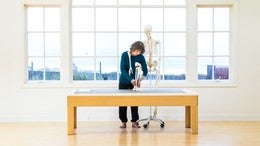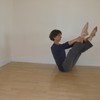Description
About This Video
Transcript
Read Full Transcript
Hi again, it's still Ruth Alpert. And uh, in this section of the tutorial, we're gonna work more with movement of your feet, um, and seeing if we can get a lot more articulation through all those 26 bones. And what was it, 107 ligaments. Um, so one of the first things that I want to talk about, cause this comes up a lot in pilates and actually in walking in all kinds of things, is the simple act of just bending and straightening. It's all over footwork. It's in the bend and stretch on the Cadillac. I'm sure you can come up with more examples than I can at this very moment.
But what happens is bending and straightening is a three joint action, right? Your hip socket, your knees, your ankles. And very often there is a hitch or a glitch in one or more of those joints. And, and so the movement gets held or restricted. So I'm gonna Bring out Eli Elisa again and I'm going to demonstrate on her what really needs to happen.
So here's the Liza and she's gonna just um, stand and do what in the dance world is called a [inaudible], which I always think of the word play, like pliable, making your legs pliable or in other worlds is just called bend, right? So this is a simple bend. What very often happens again is on go ahead and straighten up. When people bend again, if they think that their heel, that their leg goes straight down to their heel and the rest of their heel is forward, there's not a, a consciousness that there's heel in back of you. So when you bend your knees, you want to think that the heel, your heel is actually going that way. So she bends her knees, go head and her knees, her heel goes backwards and I have to grab, enter knee goes forward and straighten up cause I have to change my hand. Hold here. There you go. So if you think of heel, back, knee forward, what starts to happen is this lovely release in the front of the ankle and you get way further down than you think. Come on, straighten back up.
Thank you. Can you mimic not doing that? Can you, uh, like grip your ankles? And then what happens is all the weight stops and goes in here and you get these watermelon quads, you know, quads get built up and a lot of tension and pressure in your knee and these are not built for pressure. They get very opinionated about that. So again, a knee forward heel back and you get a really nice action in the saddle joint of your Tibia and fibula. Come on up. Thanks. So one more thought about that.
If you do what we've been talking about of your heels going back, your knees going forward, it allows your Achilles to bend more. And if you think about it, it's the beginning of a squat. Once you get that release in the front of your ankle. And here's another thought that just came to me, this release in the front of your ankle, it's really important and it also needs to be stretched. A lot of what we do with our clients, especially older clients, is we spend a lot of time stretching the Achilles, right?
He lowers different things too, because everybody gets so tight here. I'm actually finding that what's more important as important, if not more important to stretch, is the top of the in step. So I give my clients this kind of stretch to do, and there are many ways you can do it. I, you know, figured out how to put it into the bar on foot work. But this is where everybody is so tight because we're on the gas pedal in America, we're inflection the whole time. And it's actually in walking. If you walk correctly, you get that stretch as part of it. But no, everybody's in flip flops.
So they're walking like this. So the ability to release in the front and also have it open and stretched is what allows a squat to happen. Very often why people can't squat is they're stuck in their ankles. And it's also what allows child's pose, right? Very often people cannot sit like this because this is so tight.
The arches cramp, the minute they sit like this, it's not always a knee tightness. A lot of times it's the tightness here. And, uh, so I encourage you all to really start stretching there. It'll be painful. So, uh, I'm not into, uh, I have enough arguments going on in my body and enough opinionated parts so I'm not confrontational with myself. Good way to do it is stretch and release. Oh, we're not doing anything. Never mind. We didn't do it.
You didn't feel anything. Okay. Stretch again, Huh? No problem. Right. So you just, and if you do it a hundred times, you just go into it, release, go into it, release so that your nervous system doesn't have a chance to get upset about it. Uh, we're the next section. Um, we're going to go into doing footwork standing up. So you need to have something to hold on to. We're going to use the high barrel, you know, the latter part of the high barrel.
You could use the Poles on the Cadillac or a wall or a window sill, just not a door knob because the door's going to go and you know, let's not do that. So go get what you need and I'll meet you back here. We're going to talk about footwork very often I find that people have unconsciousness when they're doing of where their foot is on the bar and no matter where I placed them or what I say, you know, a thousand words doesn't really matter. It's getting the feeling in their body. That's my job as a teacher and the older I get, my job as a teacher is making my job easier. So if I can get the feeling in their body really quickly, then I don't have to talk so much and I don't have to work so hard and sorry, I'm like, I'm not into working hard. I've been a Trager practitioner for too long. What could be easier? Well, what could be easier is getting the correction quickly and as a sensation.
You do this once with people. You never have to do it again because it stays. So I have them hold on to something and you come into the v position and you do footwork standing up right when you do it, standing up, the heels stabilize what you see on the reformer. It's people go in and out right in their heels. Go up and down and no matter how much you try to get them to or you put your hand there and you're holding your heels, it just doesn't compute. But once they're doing this and it doesn't, you know, if their pelvis is a little in back or whatever, it doesn't matter.
It's really to get the sensation in their feet. And then I have them look down and I say, look at your heels. Do you notice how they're not moving? How you're pressing your heels together to stabilize that. And then I say, okay, Great. Now go to the reformer and make it feel the same.
The other thing I do is heels because people are all over their feet. When you say heels, I mean half the half there. Sometimes it's their arches half the time. So again, I have them stand up and I s if they can, they walk on their heels. If they can't do that. I ha I just, you know, you're holding on and I just say walk on your heels and then if you can, this is asking a lot, you know, it's really hard to bend your knees and keep your feet up. So you know, only if you have an athlete you can go to that.
But really the point is that you're on bone here and you want bone to be on wood or metal of the, I'm sorry I keep looking over there cause that's where their reformers, but the bar of the reformer is your floor. That's the point of this. The bar of the reformer is your floor. And so you want to connect through your bones when you're in the heel position because that will connect all the way up to your sitz bone. And then from there through your torso, if you're not connecting on your heels, you'll lose the whole back line of your body. So try that. But you know, make sure you've got something to hold on to.
And believe me, you feel this once it lasts. Thanks. And now we're going to go on to some other foot movement things. Um, you just need some open space for this. So now we're gonna play with some movement in your feet. The first one, if you imagine all those, what was it?
33 joints in your foot. How much can you move without moving in space? Can you get 33 joints moving or you know, that's the idea. Whatever you get is what you get. But the sense of internal movement, how much can your feet move internally? The rule is you can't move in space. Explore what you can do without moving in space.
Just where's the weight on your feet? Whereas, you know, can you suction them up? Can you imagine? Look, I'm doing it with my hands and if you need to do your hands, that actually can help. Um, uh, I didn't mention that. Hands and feet have very, very similar bone structures and people who are born without hands, uh, use their feet for everything. And what actually inspired my, my, uh, two year exploration of feet. Okay, here comes a story. I had a broken bone for the better part of a year.
In 1984 I fell off my bike, skidded, broke a bone, they put a metal play down, took the metal plate out, whatever it was. Six weeks later it was fully healed, no problem. Big Calcium lump. Six weeks later broke again in the same place. It didn't break into, it just fractured. The surgeon was so free towel that he kept me in a cast for a full nine month full 90 days, which is what it takes for bone to heal. So I was in the cast for much of that year and all that could work with my feet, right? I was still dancing and, and so I created this piece called footage. Of course it was a video project and a live performance and I went into a studio and would work by myself and I gave my feet tasks to do.
So this, what we're going to do now is from my old piece footage from 1984 so one of them was how much can you move your feet without moving in space? And then if you do start moving in space or, or letting your feet move a little bigger but still not taking up space, what can you do in place? But with bigger movement and you have to know, I haven't actually done footage probably since 1990 1990 so this is sort of fun to get back into it. So just playing with your feet, what can you do? How much can you roll?
And then opposite from bird feet, you have Barbie feet, you know, barbies and these permanent high heels. So I call it Barbie feet, bird feet, Barbie feet, bird feet, Barbie, feet, bird feet. And that's a useful thing to play with. And then imagine that your feet are in mud, like, and if you don't have access to mud and you live on the beach, you could think wet sand maybe, but that, that, that suctioning, that mud does. And you can always take a base and put some dirt, add some water, and play with this manufactured mud. Much better your feet than your car tires. But see what, just put that information in and see what your feet come up with.
Right? It's not any specific movement, it's just, wow, what does it make your feet feel like? If you imagine that they're in mud, right? And then you have to sort of pull your foot out of the mud.
So imagine that you're in a manufacturing place where they make down sleeping bags and jackets and you have a gas mask so you don't get allergic, right? You're not breathing in any of this, but your feet are in this vast, huge fat of feathers. And what does it feel like? Right? What do feathers feel like? How does your foot change? Right? What, what's the quality? How's the quality different? And you know how you can like set them in motion. They go and then equal time, both feet. [inaudible] take your time. You can come up with your own textures to play with.
Another uh, aspect to play with is characters. So you've got the lovers, you might need something to hold on to for this. And the curious, a really interesting thing. Your arch, I don't know about everybody, but on me, my instep fits perfectly around my calf. Who Knew? Maybe that's a sacred geometry thing. Is that true for you? Good. So yeah, you've got the caressing foot and then you've got, then you've got, uh, the flirtatious foot, right? Oh, [inaudible] [inaudible] we all, you can also give your feet the task of siblings, right? I want to go this way. Will you come play with me? I'm going over here. Come on, let's go over here. It's much more fun over there. Look alike, Elisa House, much better toys. I don't want to go. I'm over here. What am I going to do?
Oh, I guess I better come. Okay, I'm coming. I'm coming. I'm coming. But I don't like her toys. I want to go this way. Look over there, there, dolphins over there. Come on, come on. Okay, let's go. And then you get rhythms. There's this, um, I learned this in when I studied classical Indian dance when I was 16. Jacob's pillow.
You Actually Cup your foot a little bit and slap it down and you get a louder sound
There's pelvic movement in this and your sis and your knees and you've spiraled this way and that way and it goes on forever. In fact, in my Alexander technique training, we spent an entire eight hour day on walking studies. Um, so for here, I'm going to make it very simple and show you a few samples of different kinds of walk though the issue with walking as you see a lot of how people use their feet and how that use affects their posture. So I don't know if you all see this. When I was growing up, when I was in high school, there was the bop, right? The guys, right? They do the Bop. And what that was about is the heels barely touched down, right? The heels would just pop right up in the way to thrust forward. And there's not a lot of movement through their knees, bone to bone component. And the movement goes into their shoulders.
And that becomes the Groucho Marx walk too. And then there's high heels, right? Women in high heels and my mother and her generation more really tight skirts and girdles. And so you get this. And what happens when you get this as pell, the men, you know, you can, you can really see how the rest of the posture fall apart. Um, there's the tucked pelvis walk and that puts a lot of the emphasis on the heels, right? And then there's flip flops and flip flops are really, really bad for your feet because you end up just slushing right?
And in a new American words lotion, right? And this is what happens is people age, they lose the dexterity and the articulation in their feet. And so what happens is feet get stiff, my feet are stiff in the morning as I'm aging too. And so then you start moving your feet like blocks. When that happens, your balance goes and when that happens, the rest of you starts falling. And so you get this, which eventually becomes on the Walker, right? And you lose your verticality. So the, one of the big points that I emphasize with my clients and with myself is the push off the back foot. So when you walk, it's this ability to are to go into Barbie feet essentially to push to get that bend through your metatarsal and push off the back foot that that's actually what propels you forward.
Another useful aspect about pushing off your back foot is it automatically bins your knee and swings it forward. So you get the swing in your hip socket, right? But especially it helps you to bend your knee because again, what happens when you lose that pushing off the back foot, your leg, your foot goes flat and your knee loses its movement and therefore your hips lose their movement. Oh, the other walk I forgot about, that's real popular now. The guys with the pants down to here so they can't move their hip sockets at all. And then it's like I look at them sometimes and I'm like, oh my goodness, what is that fashion idea? Maybe it can go back to bed soon. Um, the other piece about pushing off the back of your foot when you're in a rush, right? And you're trying to get somewhere, what almost all of us do, and I catch myself doing this all the time as we go this way and we tried to take really fast steps, but we in, we tried to get our face to go where we're going first. But actually what propels you in space is this push off, right? If you actually push off, your whole body is gonna move forward in space and you'll, you'll get where you're trying to go a lot faster. So try that.
The next time you have to cross a street and there's a car that doesn't notice the stop sign and you have to get across the street really quickly. Push off that back foot and you'll zoom across, check it out, try it and see what you think.
Comments
Trailer from our DVD 😊 few years ago.
https://youtu.be/Fc_ZHZGcNk8
I'm an instructor with a nasty Lisfranc injury rehab in front of me, feet are essential!!
You need to be a subscriber to post a comment.
Please Log In or Create an Account to start your free trial.



















